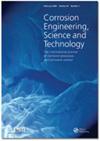316L不锈钢和铬镍铁合金625在含盐酸和高氧超临界水中的腐蚀行为表征
IF 1.5
4区 材料科学
Q4 MATERIALS SCIENCE, MULTIDISCIPLINARY
Corrosion Engineering, Science and Technology
Pub Date : 2022-08-23
DOI:10.1080/1478422X.2022.2112931
引用次数: 3
摘要
腐蚀是目前阻碍超临界水氧化(SCWO)技术商业化发展的最关键因素。以316L为代表的不锈钢和以Inconel 625为代表的镍基合金在高浓度氧和氯化物的超临界环境下的耐蚀性进行了比较。结果表明,两种样品均形成了双相层。316L不锈钢表面主要由松散的磁铁矿和赤铁矿组成,存在点蚀、微裂纹和氧化物剥落现象。内层分别为少量的Cr2O3氧化物和FeCr2O4尖晶石,这是由于铬含量较低造成的。与316L SS相比,Inconel 625的氧化膜结构由外层尖晶石和内层富cr氧化物组成。形成了一些球状氧化物,这可以用铬的挥发过程来解释。本文章由计算机程序翻译,如有差异,请以英文原文为准。
Corrosion behaviour characterisation of 316L stainless steel and Inconel 625 in supercritical water containing hydrochloric acid and high oxygen
ABSTRACT Corrosion was currently the most crucial factor hindering the commercial development of supercritical water oxidation (SCWO) technology. Stainless steel represented by 316L and Ni-based alloy represented by Inconel 625 were performed and compared with corrosion resistance in supercritical environment with high concentrations of oxygen and chlorides. The results shown that the duplex layer was formed on two samples. The surface of 316L SS was mainly composed of loose magnetite and haematite, resulted in pitting corrosion, microcracks, and the exfoliation of oxide. The inner layer were separately a small amount of Cr2O3 oxide and FeCr2O4 spinel, which were caused by the lower content of chromium. Compared with 316L SS, the oxide film structure of Inconel 625 was composed of the outer layer of spinel and the inner layer of Cr-rich oxide. Some nodular oxides were formed, and it can be explained by the volatilisation process of chromium.
求助全文
通过发布文献求助,成功后即可免费获取论文全文。
去求助
来源期刊

Corrosion Engineering, Science and Technology
工程技术-材料科学:综合
CiteScore
3.20
自引率
5.60%
发文量
58
审稿时长
3.4 months
期刊介绍:
Corrosion Engineering, Science and Technology provides broad international coverage of research and practice in corrosion processes and corrosion control. Peer-reviewed contributions address all aspects of corrosion engineering and corrosion science; there is strong emphasis on effective design and materials selection to combat corrosion and the journal carries failure case studies to further knowledge in these areas.
 求助内容:
求助内容: 应助结果提醒方式:
应助结果提醒方式:


